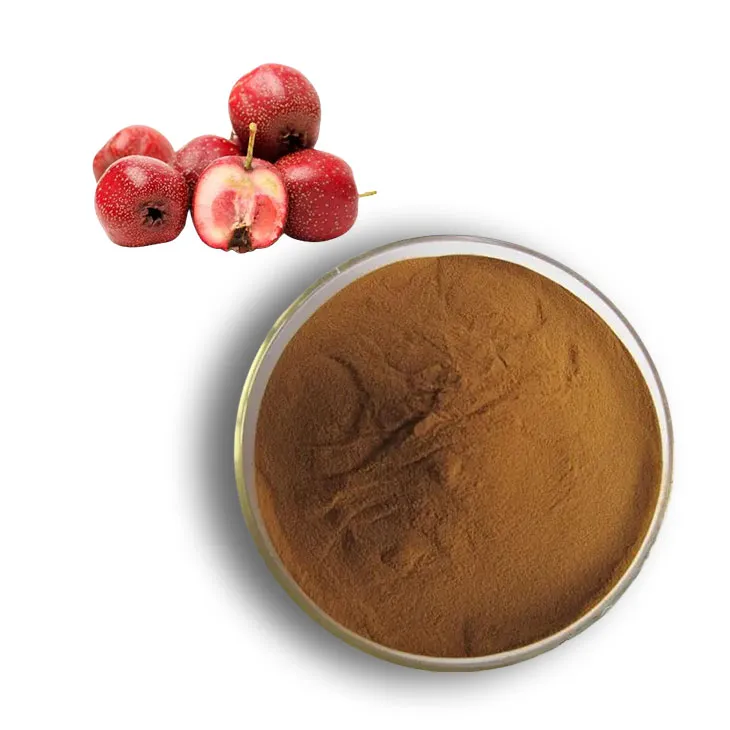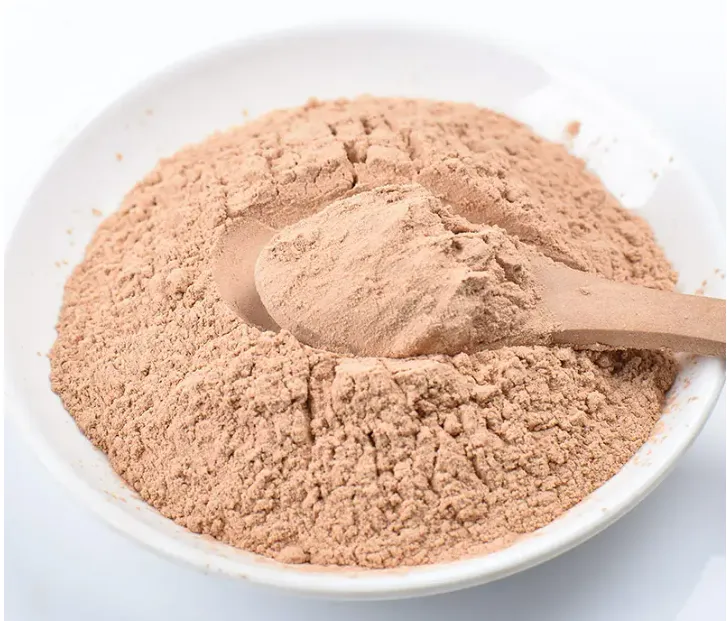- 0086-571-85302990
- sales@greenskybio.com
The process of extracting hawthorn triterpenic acids from hawthorn extract.
2024-11-27

1. Introduction
Hawthorn, a well - known plant in traditional medicine, has been widely used for its various health - promoting properties. Hawthorn triterpenic acids are among the important bioactive components in hawthorn, which possess potential pharmacological activities such as anti - inflammatory, antioxidant, and lipid - lowering effects. Therefore, the extraction of hawthorn triterpenic acids from Hawthorn Extract has become an area of great interest in the field of natural product research.

2. The Importance of Hawthorn in Traditional Medicine
Hawthorn has a long history of use in traditional medicine systems around the world. In Chinese traditional medicine, for example, hawthorn has been used to aid digestion, improve blood circulation, and relieve symptoms related to heart diseases. It is often prescribed in formulas for treating conditions such as indigestion, abdominal distension, and chest pain. The active ingredients in hawthorn are believed to work synergistically to achieve these therapeutic effects.
Similarly, in Western herbal medicine, hawthorn has been recognized for its cardioprotective properties. It has been used to support heart function, lower blood pressure, and reduce the risk of cardiovascular diseases. The use of hawthorn in traditional medicine provides a basis for the modern research on its bioactive components, especially the hawthorn triterpenic acids.

3. The Process of Extracting Hawthorn Triterpenic Acids
3.1 Selection of Hawthorn Raw Materials
The quality of hawthorn raw materials is crucial for the extraction of hawthorn triterpenic acids. High - quality hawthorn should be selected, preferably those that are ripe, free from diseases and pests, and grown in suitable environmental conditions. Different varieties of hawthorn may also have differences in the content of triterpenic acids. For example, some traditional varieties with high medicinal value may contain relatively more triterpenic acids.
Before extraction, the hawthorn fruits need to be properly pretreated. This includes cleaning to remove dirt, debris, and surface contaminants. Then, they may be dried to an appropriate moisture content, which can help in the subsequent extraction process.
3.2 Extraction Methods
There are several methods for extracting hawthorn triterpenic acids from Hawthorn Extract:
- Solvent Extraction: This is a commonly used method. Organic solvents such as ethanol, methanol, or ethyl acetate can be used. Ethanol is often preferred due to its relatively low toxicity and good solubility for triterpenic acids. The hawthorn fruits or extracts are soaked in the solvent for a certain period of time, usually at a specific temperature and agitation rate. For example, a common extraction condition could be using 70% ethanol at a temperature of 60 - 80 °C with gentle agitation for 2 - 4 hours. This allows the triterpenic acids to dissolve into the solvent.
- Supercritical Fluid Extraction: Supercritical carbon dioxide (scCO₂) can be used for extraction. This method has the advantages of being environmentally friendly, having a high extraction efficiency, and leaving no solvent residue. The critical temperature and pressure of CO₂ are relatively easy to achieve in the laboratory or industrial settings. By adjusting the pressure, temperature, and addition of co - solvents (such as ethanol), the selectivity and extraction efficiency of hawthorn triterpenic acids can be optimized.
3.3 Separation and Purification
After extraction, the resulting solution contains not only hawthorn triterpenic acids but also other impurities. Therefore, separation and purification steps are necessary.
Filtration: The first step is often filtration to remove large particles, such as undissolved plant debris. This can be achieved using filter papers or membrane filters with appropriate pore sizes.
Evaporation: The solvent in the filtrate is then evaporated to concentrate the sample. This can be done under reduced pressure to lower the boiling point of the solvent and avoid thermal degradation of the triterpenic acids. For example, using a rotary evaporator at a temperature below 60 °C and a reduced pressure of - 0.08 - - 0.1 MPa.
Chromatographic Separation: Chromatography techniques such as column chromatography or high - performance liquid chromatography (HPLC) are used for further purification. In column chromatography, a suitable stationary phase (such as silica gel or C18) and a mobile phase (such as a mixture of solvents) are selected. The sample is loaded onto the column, and different components are separated based on their differential affinities to the stationary and mobile phases. HPLC offers higher resolution and can be used for the final purification to obtain highly pure hawthorn triterpenic acids.

4. Optimization of the Extraction Process
To obtain high - quality hawthorn triterpenic acids for various applications, the extraction process needs to be optimized.
4.1 Optimization of Extraction Parameters
The extraction parameters such as solvent concentration, extraction temperature, extraction time, and solvent - to - sample ratio play important roles in the extraction efficiency. For example, by conducting a series of experiments using different ethanol concentrations (ranging from 50% to 90%), it can be determined that a certain concentration may result in the highest extraction yield of triterpenic acids. Similarly, varying the extraction temperature and time can help to find the optimal conditions. A response surface methodology can be used to design experiments and analyze the effects of multiple factors simultaneously, which can save time and resources in the optimization process.
4.2 Selection of Appropriate Extraction Methods
Different extraction methods have their own advantages and disadvantages. For small - scale laboratory research, solvent extraction may be more convenient and cost - effective. However, for large - scale industrial production, supercritical fluid extraction may be more favorable due to its high efficiency and environmental - friendliness. The selection should be based on the specific requirements of production scale, cost, and product quality.
4.3 Quality Control during the Extraction Process
Throughout the extraction process, quality control is essential. This includes monitoring the content of hawthorn triterpenic acids at different stages of extraction, purification, and drying. Analytical techniques such as HPLC can be used to accurately measure the concentration of triterpenic acids. In addition, strict control of environmental factors such as temperature, humidity, and cleanliness in the extraction and purification areas can also ensure the quality of the final product.
5. Applications of Hawthorn Triterpenic Acids
High - quality hawthorn triterpenic acids obtained through the optimized extraction process have a wide range of applications.
- Pharmaceutical Industry: They can be used as raw materials for developing new drugs. Their anti - inflammatory and antioxidant properties make them potential candidates for treating various inflammatory diseases and preventing oxidative stress - related disorders. In addition, their lipid - lowering effects may be beneficial for the treatment of hyperlipidemia and related cardiovascular diseases.
- Food and Beverage Industry: Hawthorn triterpenic acids can be added to functional foods and beverages as natural additives. They can enhance the health - promoting functions of products, such as improving digestion and reducing the risk of heart diseases. For example, they can be added to hawthorn - flavored drinks or health - promoting teas.
- Cosmetic Industry: In the cosmetic industry, the antioxidant properties of hawthorn triterpenic acids can be utilized. They can be incorporated into skin care products such as creams, lotions, and serums to protect the skin from oxidative damage, delay skin aging, and improve skin health.
6. Conclusion
The extraction of hawthorn triterpenic acids from Hawthorn Extract is a complex but important process. Through careful selection of raw materials, appropriate extraction methods, and optimization of the extraction process, high - quality hawthorn triterpenic acids can be obtained. These bioactive compounds have great potential in various fields such as pharmaceuticals, food, and cosmetics. Future research should focus on further improving the extraction efficiency, exploring new applications, and ensuring the safety and efficacy of hawthorn triterpenic acids - based products.
FAQ:
Q1: Why is hawthorn important in traditional medicine?
Hawthorn has been used in traditional medicine for various reasons. It is often associated with promoting heart health, such as improving blood circulation and regulating blood pressure. It may also have digestive benefits, helping with issues like indigestion and stomach discomfort. Additionally, it has antioxidant properties that can contribute to overall well - being.
Q2: What are the key steps in the selection of hawthorn raw materials for extracting hawthorn triterpenic acids?
The selection of hawthorn raw materials is crucial. Firstly, the variety of hawthorn needs to be considered. Different varieties may have different contents of triterpenic acids. Then, the quality of the hawthorn fruits should be examined, including their ripeness, absence of diseases and pests. The origin of the hawthorn also matters as environmental factors can influence the chemical composition of the fruits.
Q3: How can the extraction process of hawthorn triterpenic acids be optimized?
To optimize the extraction process, several factors can be adjusted. The choice of extraction solvent is important. Solvents with appropriate polarity can enhance the extraction efficiency. The extraction time and temperature also play significant roles. Longer extraction time and appropriate temperature can increase the yield, but they need to be carefully controlled to avoid degradation of the triterpenic acids. Additionally, the use of advanced extraction techniques like ultrasonic - assisted extraction or microwave - assisted extraction can improve the process.
Q4: What are the common purification methods for hawthorn triterpenic acids after extraction?
Common purification methods include chromatography techniques. For example, column chromatography can be used to separate hawthorn triterpenic acids from other impurities based on their different affinities to the stationary phase. Recrystallization is also a method, which can further purify the triterpenic acids by taking advantage of their solubility characteristics in different solvents.
Q5: What are the potential applications of high - quality hawthorn triterpenic acids?
High - quality hawthorn triterpenic acids have various potential applications. In the pharmaceutical field, they may be used for developing drugs related to heart diseases or anti - inflammatory drugs. In the cosmetic industry, they can be added to products for their antioxidant and skin - protecting properties. They may also have potential in the food industry as natural additives with health - promoting functions.
Related literature
- Extraction and Characterization of Bioactive Compounds from Hawthorn"
- "Optimization of Hawthorn Triterpenic Acid Extraction for Pharmaceutical Applications"
- "The Role of Hawthorn in Traditional and Modern Medicine"
- ▶ Hesperidin
- ▶ Citrus Bioflavonoids
- ▶ Plant Extract
- ▶ lycopene
- ▶ Diosmin
- ▶ Grape seed extract
- ▶ Sea buckthorn Juice Powder
- ▶ Fruit Juice Powder
- ▶ Hops Extract
- ▶ Artichoke Extract
- ▶ Mushroom extract
- ▶ Astaxanthin
- ▶ Green Tea Extract
- ▶ Curcumin
- ▶ Horse Chestnut Extract
- ▶ Other Product
- ▶ Boswellia Serrata Extract
- ▶ Resveratrol
- ▶ Marigold Extract
- ▶ Grape Leaf Extract
- ▶ New Product
- ▶ Aminolevulinic acid
- ▶ Cranberry Extract
- ▶ Red Yeast Rice
- ▶ Red Wine Extract
-
Hawthorn Extract
2024-11-27
-
Red Date Extract
2024-11-27
-
Lavender Extract
2024-11-27
-
Chaste Berry Extract
2024-11-27
-
Cocoa Extract
2024-11-27
-
Clove Powder
2024-11-27
-
Tongkat Ali Extract Powder
2024-11-27
-
Tongkat Ali Extract
2024-11-27
-
Phyllanthus Emblica Extract
2024-11-27
-
Golden Seal Extract
2024-11-27




















